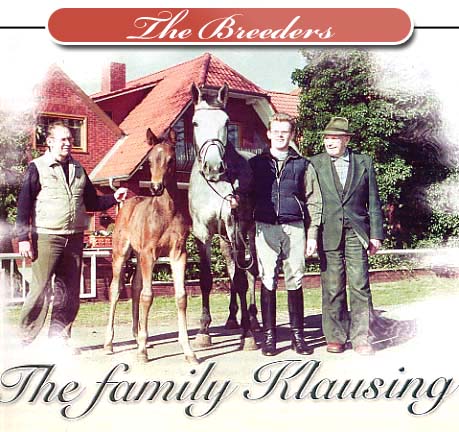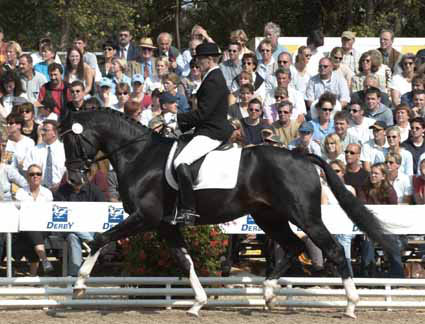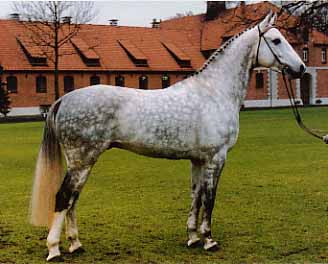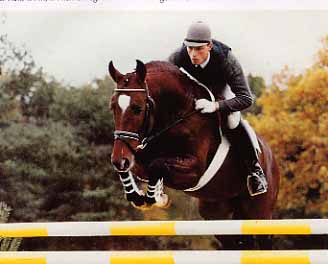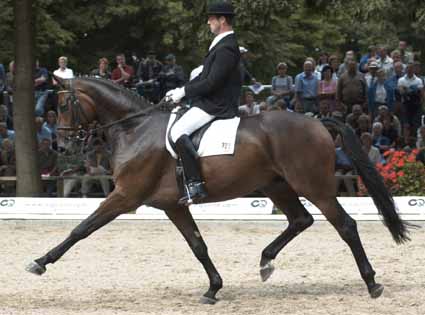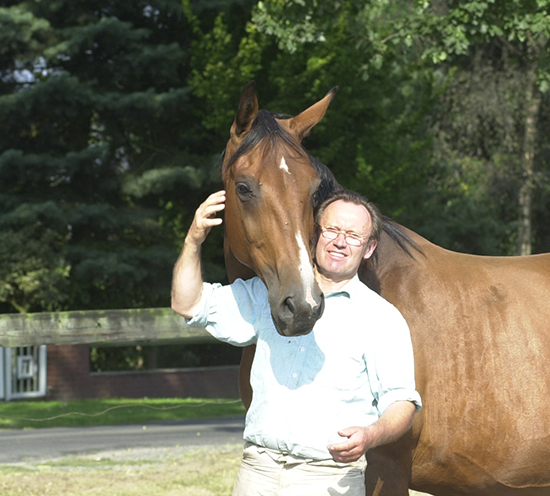One of Germany’s most famous breeding farms has a real Aussie connection, for it was the birthplace of the Australian dressage horse and Olympic team member – Crisp. But this is no exclusively focussed horse farm; the Klausing family is based on a 200 hectare farm near Diepholz, where 130 of those hectares are used to grow potatoes. The farm also grows oats and corn and raises pigs and cattle… and horses.
There are three generations of the Klausing family – Heinrich, his son, Wilhelm, and grandson, Heiko – all still living on the property.
Heinrich Klausing is largely retired now, and the direction of the breeding program is the hands of Wilhelm assisted by his son Heiko, a very successful trainer/rider of young dressage horses – and now moving into FEI dressage ranks.
Heiko Klausing at the 2002 Bundeschampionate on Sir Oldenburg (Sion / Contender)
The whole family from grandfather to grandchild have been involved in breeding horses for the past 80 years, in that time they have produced 35 approved stallions and more than 50 state’s premium mares.
The family speaks the German dialect – Plattdeutsch. When grandfather Heinrich and his son, Wilhelm start to talk, the average German would only understand a fraction of what they say. Most of what would be recognizable are stallion names! But it is easy for the Klausings to switch from the dialect to ordinary German, and in the case of the grandson, Heiko, English is also an option, and Heiko’s sister-in-law, Sylvia (married to the eldest son, Willem) speaks absolutely splendid English and helped us greatly on our visit.
Ninety one year old Heinrich Klausing has been associated with the breeding program on the family farm since 1918. First the family bred very strong horses for agriculture. These were the times when the foals would run around the fields following their mothers at work.
When Wilhelm Klausing took over the direction of the breeding there were 15 horses, today, there are more than 40 brood mares, up to seven young stallions and 15 horses in training, from yearlings to three years old.
Once again, we see the shift that has taken place in German horse breeding. Whereas in former times the breeders knew nothing about training or competition, nowadays, more and more they see the need to show their horses successfully in the competition arena. The sons and daughters of the traditional breeders are now being sent off to acquire riding and training skills – so it is with the family Klausing.
The training of the horses is a section of the farm activities that only commenced five years ago, when Heiko, who is now 26 years old, completed his apprenticeship with Wolfram and Brigitte Wittig. The Wittigs are well known producers of dressage horses – both for young horse classes and for competition at the highest level.
In 1995 Heiko took over responsibility for training the young horses – and he is also one of the Vechta Auction team of riders. Older brother, Willem (28) took over the farming side of the establishment, in particular, care of the family’s 180 hectares of potatoes.
Heading Heiko’s competition team is the 14 year old Al Mansur, a son of Argentinus, bred by Wilhelm Klausing from a Cardinal mare. Heiko has trained this horse to Grand Prix, taking fourth place at the German Young Riders Championship at Balve in 1995. Out of the same mare line as Al Mansur, comes Crisp (by Consul) who was ridden by Ricky MacMillan in the Australian dressage team at the Sydney Olympic Games, after earlier in the year representing Australia at the World Cup final.
Wilhelm Klausing is especially known as a ‘stallion raiser’. His breeding program produced Celle State Stud sires Willem’s As (Watzmann/Pokal), Foxhunter (Watzmann/Inschallah) – above – and Perpignon (Pilot/Watzmann) – below. The State’s Premium mare, Whyoming is the dam of Perpignon, she is also the sister of Wilhem’s As and a half sister to former State Sire, Dupont.
The most notable breeding successes of recent times have been Placido and Ramina K. Placido (below) sold for DM360,000 at the Verden Auction in 1998. Two years later, Ramina K also topped the Auction, sold for DM300,000 to Swiss rider (and Olympic gold medallist) Sissy Max Theurer for DM300,000.
In the case of Placido, the gelding is a double triumph for the Klausings – since he is by Prestige Pilot. Prestige Pilot is by Pilot out Debutant who descends from the Duellant line, and carries the blood of Marcio xx and Steinpilz xx. Prestige Pilot was purchased as a foal by Wilhelm Klausing from his breeder, Heinrich Borcherding, and while he is still owned by Mr Klausing, currently stands at the Kathmann stallion station. Prestige Pilot won in jumping and dressage competitions up to M level.
So why did a Hanoverian breeder of predominantly dressage horses, pick a colt by the Westfalien jumping great Pilot.
“I really liked the way he was so loose and free in his movement as a foal,” says Wilhelm Klausing, “Pilot is an interesting stallion – he puts on a dream of a canter, and Hanoverian breeding hasn’t concentrated enough on the canter in recent times.”
Placido is out of a mare from the most successful mare line in the Klausing program – a mare who traces to the foundation mare Colette. By Wöhler, Colette is out of ‘pre-studbook mare 389’ by Gaugraf (Goldhammer II/Flugfeuer II). Dear old ‘389’ was used as a workhorse until the end of the 50’s when she was bred to Wöhler to produce Colette – alias S 26-470. Over the next ten years she delivered nine foals for Heinrich Klausing – including one Verden auction horse and five main studbook mares.
The most impressive of the mares were Persante and Pension, both by the Thoroughbred stallion Perser xx. Perser is a full-brother to the rather more famous Pik As xx, an exceptional producer of jumping horses. The stallions were by Abendfrieden xx out of Pechfackel xx.
Persante was sold at the Verden Auction, while Pension went on to produce nine foals for the Klausings. Two of her sons, Every Day and Walkman competed in lower level jumping, while another son, Flamboe was 3rd in the Three Year Old class at the Bundeschampionate before being sold at the Vechta Auction for DM80,000 to the States. Pension’s elegant black daughter, Adelskrone (by Absatz) was also sold through the auction, this time to Austria for DM19,000, but not before she had a filly foal, Inka, by Inschallah AA.
Inka’s most famous son is Picasso by Pokal (by Poet xx). Picasso produced mainly jumpers, with earnings from his progeny of DM345,861. He stood at Grönwohldhof from 1982 to 1989, before moving to the State Stud at Neustadt, where he served from 1990 to his death in 1993. His most famous son is Prinz Oldenburg (out of a mare by Pik Bube I).
Inka is also the dam of Celle stallion, Foxhunter by Watzmann. Foxhunter’s offspring include the Seoul Olympic team gold medalist, Walzerkoenig (ridden by Franke Sloothaak). Foxhunter has stood at Spruce Meadows in Canada since 1998, although his son Fortunas returned to Germany to stand at Paul Schockemöhle’s Oldenburg stud.
Inka’s daughter Peggy (by Pokal) born in 1978 was the best of the eight daughters and became the main stay of the breeding program now in the hands of Wilhelm.
Peggy produced three state stud stallions, an approved stallion, two state’s premium mares and several performance horses. Bred to Diskus she produced the successful jumper, Der Picasso, ridden by Dr Michael Rüping and the state stud sire, Dupont who stood from 1987 to 1990.
Then, bred to Watzmann, she produced two jumpers, Wintergame 2 and Wellington, the approved stallion Waltzertraum, as well as Willem’s As I and II and the state’s premium mare, Whyoming.
So far, Whyoming has produced six foals including a state stud sire and a Bundeschampion. The stallion is Perpignon, by the great Westfalien, Pilot. Perpignon excelled in the jumping at his performance test and has gone on to be a useful competitor ridden by Joachim Winter.
The gelding, Placido, by Prestige Pilot, is another exceptional son of Whyoming.
Placido was a sensation right from the start. Topping the Verden Auction, bronze at the Young Horse Championships in Arnheim, and then two years running, Champion first in the five year old class, then in the six year old class, at the Bundeschampionate. He was sold for DM1,050,000 at the PSI 2000 auction to British based Dr Bertolschimer, but returned to Germany for Ulf Möller to ride him to the six-year-old title at the Bundeschampionate.
So what are the bloodlines that Mr Klausing looks for?
“Weltmeyer, Donnerhall, Rubinstein for the rideability and Rohdiamant. I like Florestan and Fidermark, and the Bolero blood – and more recently, Lauries Crusador.”
Of the young sires?
“We must wait on the younger stallions like Londonderry and Rotspon, I have already bred one foal by Waterford, The De Niros look very good as foals. But we always come back to Weltmeyer…”
“You need some Thoroughbred blood, but if you can go with a modern Warmblood type with some blood, it is better. The main thing is to go for a stallion that has a good motor, a good back end.”
It is an interesting breeding program, where Mr Klausing is not afraid to mix jumping and dressage lines, following his own eye and instinct rather than the fashion of the day. It is a breeding program that proves just once again, how crucial that one foundation mare always is!
This article first appeared in the February 2002 edition of The Horse Magazine



